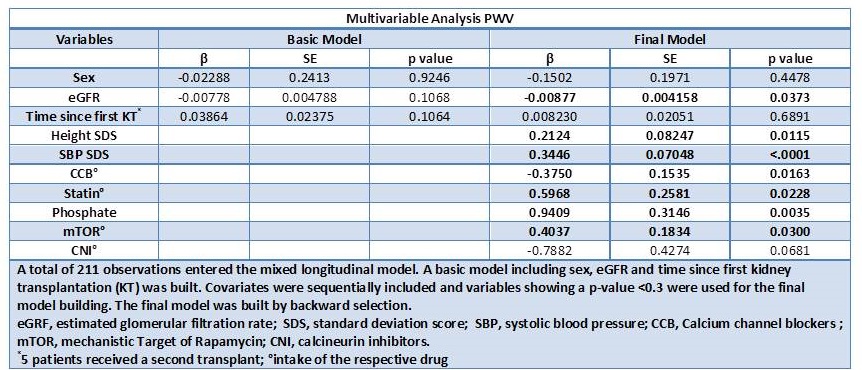Consistent High Burden of Arteriosclerosis in Pediatric Kidney Transplant Recipients
1Department of Pediatric Kidney, Liver and Metabolic Diseases, Hannover Medical School, Hannover, Germany, 2Pediatric Nephrology, University Medical Center Hamburg-Eppendorf, Hamburg, Germany, 3Department of Pediatrics, Asklepios Klinik Nord - Heidberg, Hamburg, Germany, 4Pediatric Nephrology, University Hospital, Essen, Germany, 5Department of Nephrology and Hypertension, Hannover Medical School, Hannover, Germany
Meeting: 2019 American Transplant Congress
Abstract number: C233
Keywords: Dyslipidemia, Kidney/liver transplantation, Renal function
Session Information
Session Name: Poster Session C: Kidney: Pediatrics
Session Type: Poster Session
Date: Monday, June 3, 2019
Session Time: 6:00pm-7:00pm
 Presentation Time: 6:00pm-7:00pm
Presentation Time: 6:00pm-7:00pm
Location: Hall C & D
*Purpose: The second most common cause of death in pediatric kidney transplant (KT) recipients are cardiovascular (CV) diseases. We have previously shown that pulse wave velocity (PWV), an indicator of arteriosclerosis and subclinical CV damage, improves early after pre-emptive transplantation. In this study we seek to determine predictors for PWV at later time after KT.
*Methods: We enrolled 109 pediatric renal transplant recipients (age: 5-18 years) from 3 German transplant centers in a prospective longitudinal study. To date, follow-up visits are available for 82, 53, 32 patients at 2, 4 and 6 years after initial inclusion. At each visit we performed a detailed and comprehensive assessment of CV risk factors (incl. blood pressure monitoring) and aortic pulse wave velocity (PWV).
*Results: At a median of 4.9 (range <1 to 14.3) years after transplantation, a fifth (22%) of KT recipients displayed elevated PWV values (defined as PWV-SDS >95th pct.) indicating the presence of arteriosclerotic processes. When including all visits in a mixed linear model, we were able to identify lower GFR, greater height-SDS, higher systolic blood pressure, higher phosphate levels, the intake of statins and of mTOR-inhibitors as independent risk factors of elevated PWV. The intake of calcium channel blockers, however, was associated with lower PWV levels.
*Conclusions: Long term pediatric KT recipients show a significant burden of subclinical CV organ damage. Our results suggest that classical CV risk factors (blood pressure, dyslipidemia) as well as non-classical risk factors (renal function, phosphate, use of immunosuppression) play a role in pediatric KT recipients. Further studies need to address how preventive measures can improve CV health of pediatric KT recipients.
To cite this abstract in AMA style:
Ostendorf K, Memaran N, Borchert-Mörlins B, Born Jvonder, Bauer E, Wick Avon, Oh J, Kemper MJ, Büscher R, Schmidt BM, Melk A. Consistent High Burden of Arteriosclerosis in Pediatric Kidney Transplant Recipients [abstract]. Am J Transplant. 2019; 19 (suppl 3). https://atcmeetingabstracts.com/abstract/consistent-high-burden-of-arteriosclerosis-in-pediatric-kidney-transplant-recipients/. Accessed December 25, 2025.« Back to 2019 American Transplant Congress

